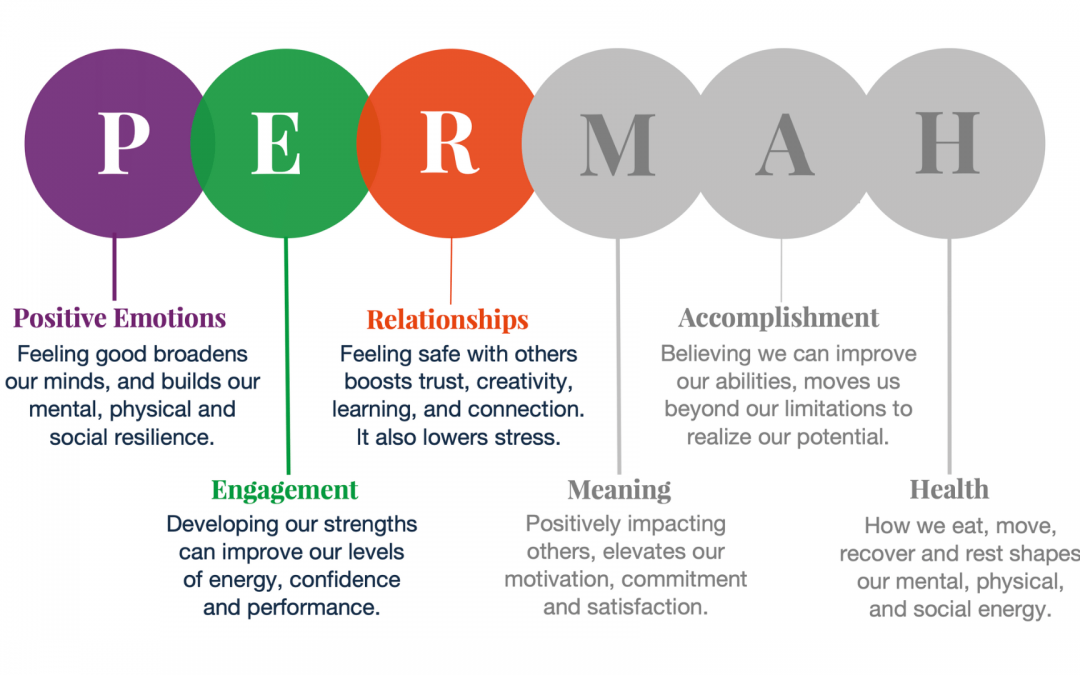
Using PERMAH for your POSITIVE DUTY
Latest News & Events
Using PERMAH for your POSITIVE DUTY

Above image is courtesy of The Wellbeing Lab/Michelle McQuaid Group.
Background
Under Workplace Health and Safety laws, a positive duty to eliminate or control psychosocial hazards has been imposed on all persons conducting a business or undertaking.
This means that the traditional compliance approach of issuing a policy and procedures, providing them to workers, requiring their compliance with them and acting on incidents or breaches when they are reported is not adequate any more.
It is necessary to conduct a thorough risk assessment to see whether any risks from each of the 14 psychosocial hazards in the Model code for managing psychosocial hazards published by Safe Work Australia and as set out in legislation enacted by each State or Territory.
There is also a duty to consult workers at each stage of the process and especially in relation to identifying risks and designing and implementing control plans and measures.
One way to start addressing both the risk assessment and consultation obligations is to survey workers with an appropriate survey instrument. Our choice to do that is the PERMAH Workplace Wellbeing Survey.
Why have we chosen PERMAH?
The PERMAH workplace wellbeing framework is based on the ground-breaking wellbeing theory developed by Professor Martin Seligman as published in his celebrated work “Flourish”.
The PERMAH survey tool has been used by the Australian Human Resources Institute since 2018 as a national workplace wellbeing benchmarking tool and Small Business Victoria as the centrepiece of its small business wellbeing programs.
A unique feature of the PERMAH Survey is that every person who does the survey gets their own individual State of Wellbeing Report plus a template for developing a wellbeing plan plus access to a heap of wellbeing resources….all for free.
Organisations with 30 or more employees can acquire an annual licence and obtain organisational reports which show the aggregated findings on wellbeing in the organisation through the eyes and experiences of its people.
We have a team of people who have undertaken Certificates in Creating Wellbeing and in Leading Psychological Safety and Care and are accredited to debrief people on their PERMAH Survey results.
With the advent of the positive duty to eliminate or control psychosocial hazards, the survey has been augmented with a panel of additional questions specifically related to each of the 14 psychosocial hazards detailed in Safe Work Australia’s model code.
So we believe that the PERMAH Workplace Survey with the Psychosocial Hazard Panel Add-on ticks all of the boxes – it is science-based, it has credibility being used nationally by AHRI, it is affordable, it provides free and practical wellbeing advice and resources to everyone who does it and it addresses the psychosocial hazards in a practical and cost effective way.
How we can we help
Our “Using PERMAH for Positive Duties” service incorporates the following elements:
- A 12 month licence for the PERMAH Workplace Wellbeing Survey including the add-on psychosocial hazard panel.
- Ability to undertake the survey as an organisation multiple times during the licence period.
- Templates and an animated video for communications to employees on the PERMAH Workplace Wellbeing Survey, why your organisation is doing it and how employees can participate.
- Professional analysis of survey results, provision of a supplementary report and management debrief on the results.
We have the flexibility to package these elements in a variety of ways and to undertake other services such as individual PERMAH debriefings, training programs and facilitated sessions with leadership groups or consultative or safety committees.
Where to now?
If you would like to learn more about the positive duty to eliminate or control psychosocial hazards and your options for addressing it, we’ll be happy to advise you. Just give us a call on 0438 533 311 or email enquiries@ridgelinehr.com.au.
CONTACT US
Ridgeline Human Resources Pty Ltd
ABN : 24 091 644 094
enquiries@ridgelinehr.com.au
0438 533 311
PARTNER LINKS
QUICK RESOURCE LINKS









